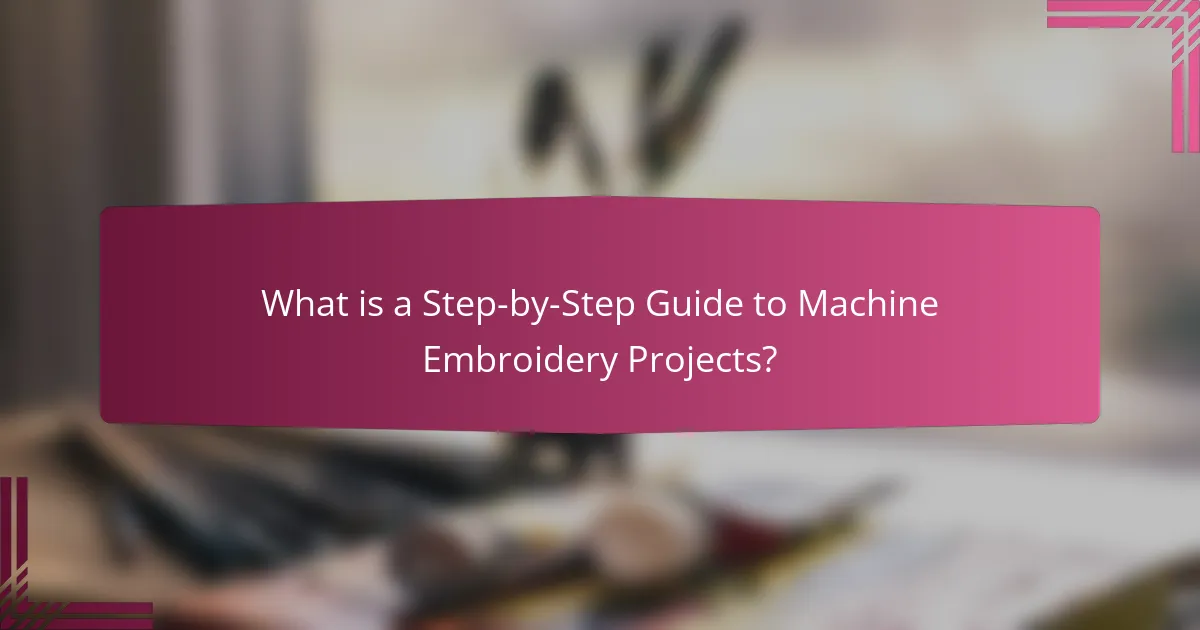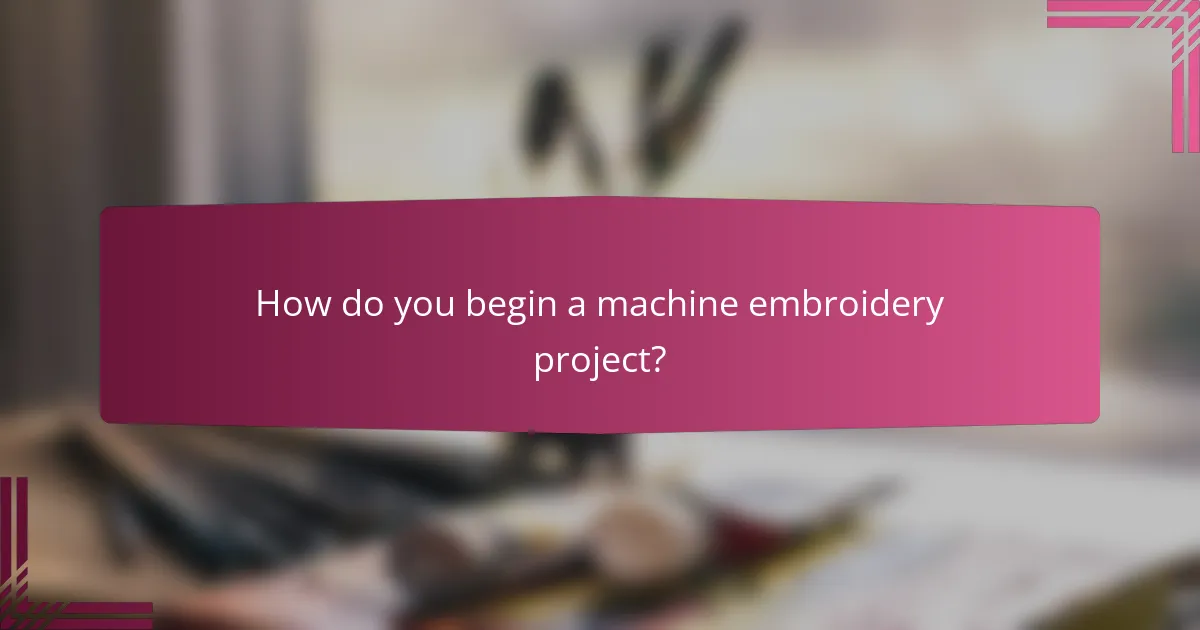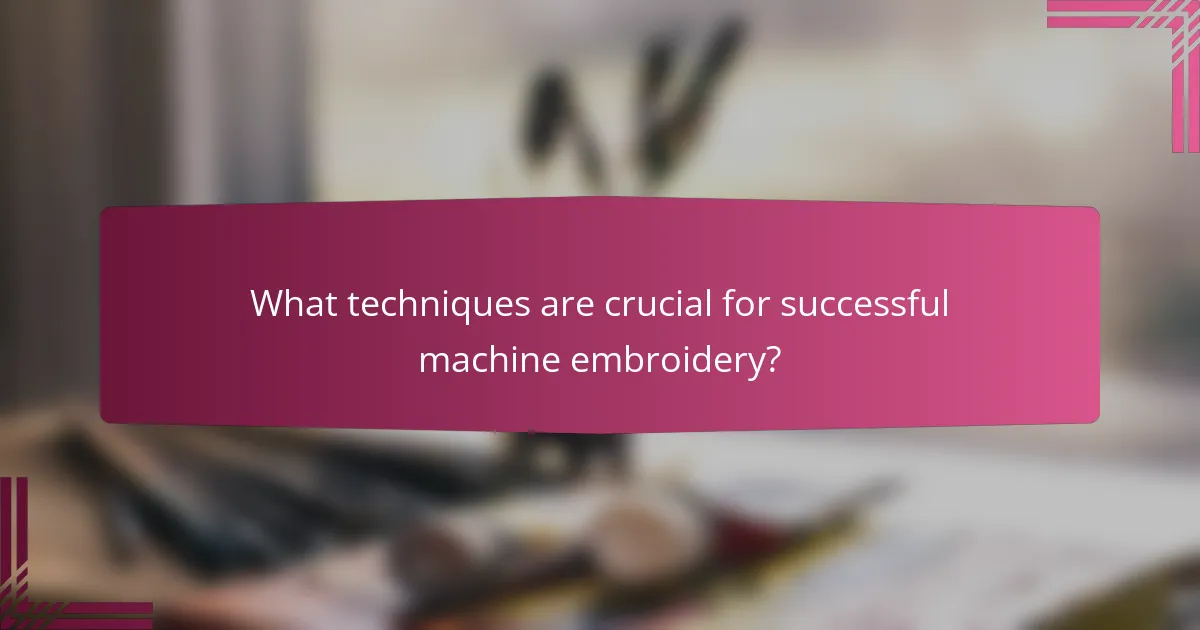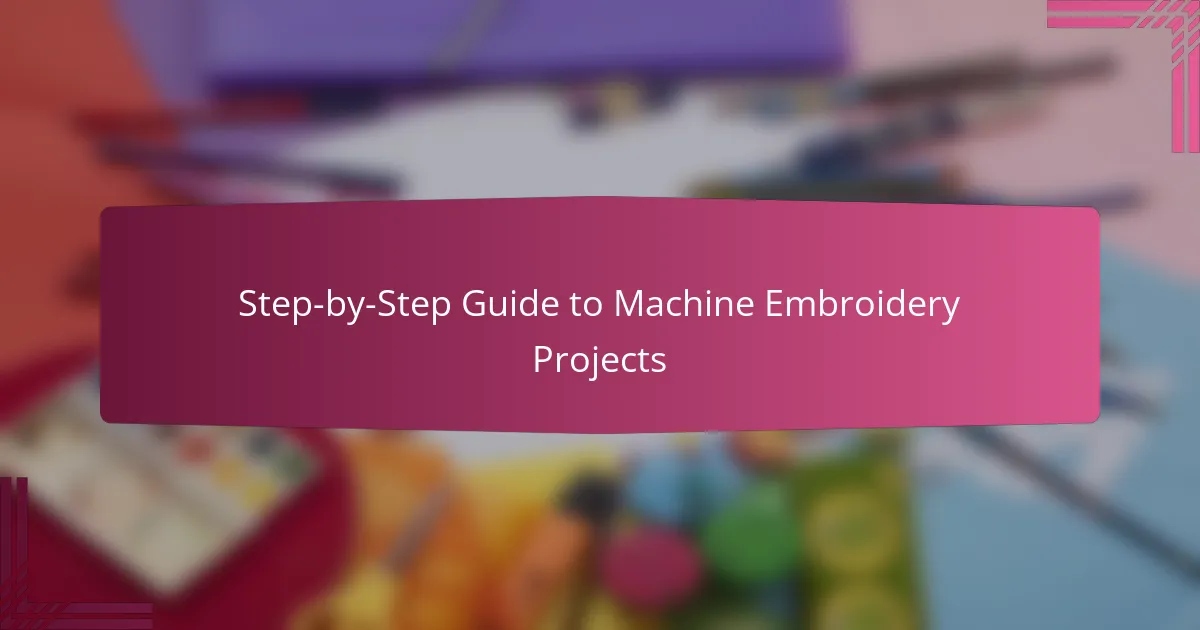
What is a Step-by-Step Guide to Machine Embroidery Projects?
A step-by-step guide to machine embroidery projects involves several key phases. First, gather necessary supplies, including an embroidery machine, thread, fabric, and stabilizer. Next, select a design and transfer it to the machine. Prepare the fabric by hooping it securely with the stabilizer.
Then, set the machine to the appropriate settings for the chosen design. Start the embroidery process, monitoring the machine to ensure proper stitching. Once completed, carefully remove the fabric from the hoop and trim any excess stabilizer. Finally, finish the project by pressing the fabric and making any necessary adjustments or embellishments.
This process is widely adopted by crafters and has been documented in numerous instructional resources, ensuring its validity and effectiveness in machine embroidery.
How can a step-by-step guide enhance your machine embroidery skills?
A step-by-step guide can enhance your machine embroidery skills by providing structured instructions. It breaks down complex techniques into manageable tasks. This approach allows for easier understanding and execution of each step. Clear visuals often accompany these guides, aiding in comprehension. Consistent practice following the guide reinforces learning. Additionally, it helps identify and correct mistakes in real time. Research indicates that structured learning improves skill acquisition in crafts. This method fosters confidence and encourages experimentation with new designs.
What are the key elements of a comprehensive machine embroidery guide?
A comprehensive machine embroidery guide includes essential elements such as equipment, techniques, and project instructions. Equipment refers to the sewing machine, embroidery hoops, and threads. Techniques encompass digitizing designs, stabilizing fabrics, and thread tension adjustment. Project instructions provide step-by-step processes for creating specific items. These elements ensure users can effectively learn and execute machine embroidery. Accurate guidance in these areas enhances the overall experience and outcome of embroidery projects.
Why is a structured approach important in machine embroidery?
A structured approach is important in machine embroidery because it ensures precision and consistency in the final product. This methodical process helps in planning each step, from design selection to fabric preparation. It minimizes errors that can occur during stitching, which can lead to wasted materials and time. A structured approach also facilitates better organization of tools and materials needed for the project. By following a clear sequence, embroiderers can achieve desired results more efficiently. Studies show that organized workflows in crafting lead to a 30% increase in productivity. This structured methodology promotes skill development and enhances overall project satisfaction.
What materials are essential for machine embroidery projects?
Essential materials for machine embroidery projects include embroidery thread, stabilizer, fabric, and needles. Embroidery thread comes in various types, such as polyester and rayon, which affect the finish of the project. Stabilizer is crucial for providing support to the fabric during stitching. Different stabilizers, like tear-away and cut-away, serve specific purposes based on the fabric type. The fabric chosen must be compatible with the embroidery technique used. Needles designed for embroidery have a larger eye to accommodate thicker threads. These materials collectively ensure a successful machine embroidery project.
Which types of fabrics are best suited for machine embroidery?
Cotton, polyester, and blends are the best fabrics for machine embroidery. Cotton is durable and holds stitches well. Polyester offers strength and resists fading. Blends combine the benefits of both materials. Lightweight fabrics like silk and satin can be used but require careful handling. Heavier fabrics like canvas and denim also work, providing stability. Each fabric type affects the final appearance and durability of the embroidery. Choosing the right fabric ensures optimal stitch quality and design clarity.
What tools and equipment do you need to start machine embroidery?
To start machine embroidery, you need a sewing machine capable of embroidery. This type of machine often has built-in designs and the ability to read embroidery files. You will also require embroidery thread, which comes in various colors and types. Additionally, you need embroidery needles that are specifically designed for this purpose.
Stabilizers are essential to support the fabric during stitching. They prevent distortion and help achieve clean results. An embroidery hoop is necessary to hold the fabric taut while you work. Lastly, software for digitizing designs can be helpful if you want to create custom patterns. These tools and equipment are fundamental for successful machine embroidery projects.

How do you begin a machine embroidery project?
To begin a machine embroidery project, first select a design. Choose a design that suits your skill level and project goals. Next, gather your materials, including fabric, stabilizer, and thread. Ensure the fabric is properly prepared and hooped for the machine. Then, load the design onto the embroidery machine. Adjust the settings according to the fabric type and thread used. Finally, run a test stitch to confirm the design quality before proceeding with the actual project.
What steps should you follow to prepare for your first project?
Identify your project goals clearly. Define what you want to achieve with your machine embroidery project. Gather necessary materials, including fabric, thread, and stabilizers. Familiarize yourself with your embroidery machine and its settings. Create or select a design that suits your project. Test your design on scrap fabric to ensure compatibility. Prepare your workspace to have all tools at hand. Review and follow any specific instructions related to your design or machine.
How do you choose a design for your embroidery project?
To choose a design for your embroidery project, consider your personal style and the project’s purpose. Identify the theme or message you want to convey. Research various design options that align with this theme. Evaluate the complexity of each design in relation to your skill level. Ensure the design is suitable for the fabric type you will use. Check the size of the design to fit your project dimensions. Finally, select a design that you find visually appealing and enjoyable to stitch.
What are the best practices for hooping your fabric?
The best practices for hooping your fabric include ensuring the fabric is smooth and taut. Start by pre-washing and ironing the fabric to eliminate wrinkles. Use the appropriate hoop size for your project. Place the fabric in the hoop, ensuring it is centered. Tighten the hoop securely to prevent shifting during embroidery. Check for any puckering or distortion in the fabric. Adjust the tension as needed before starting the machine. Proper hooping helps achieve accurate and professional results in machine embroidery.
How can you effectively set up your embroidery machine?
To effectively set up your embroidery machine, start by ensuring it is on a stable surface. Check that the power cord is securely connected and the machine is plugged in. Next, thread the machine according to the manufacturer’s instructions. Use the correct needle size and type for your fabric. Select the appropriate embroidery design and load it into the machine. Adjust the tension settings as needed for the specific thread and fabric combination. Finally, perform a test stitch on scrap fabric to verify the setup. This methodical approach ensures optimal performance and quality in your embroidery projects.
What settings should be adjusted for optimal results?
Adjust the tension settings for optimal results in machine embroidery. Proper tension ensures that threads lay flat and do not pucker. Additionally, adjust the stitch length according to the fabric type. A shorter stitch length is ideal for dense fabrics, while a longer stitch length works for lighter materials. The needle type should also be matched to the fabric; use a ballpoint needle for knits and a sharp needle for woven fabrics. Lastly, calibrate the speed settings based on the complexity of the design. Slower speeds are beneficial for intricate patterns, while faster speeds can be used for simpler designs.
How do you thread your machine correctly?
To thread your machine correctly, start by raising the presser foot. This action releases tension on the threading mechanism. Next, place the spool of thread on the spool pin. Pull the thread through the thread guide, ensuring it is positioned correctly. Then, thread the tension discs by guiding the thread between them. After that, pass the thread down through the take-up lever and back down to the needle. Finally, thread the needle from front to back. Following these steps ensures proper threading for smooth operation.

What techniques are crucial for successful machine embroidery?
Crucial techniques for successful machine embroidery include proper hooping, stabilizer selection, and thread tension adjustment. Proper hooping secures the fabric, preventing movement during stitching. Stabilizers support the fabric and prevent distortion, with choices varying based on fabric type. Adjusting thread tension ensures even stitches and prevents thread breakage. Additionally, selecting the right needle type and size is essential for different fabrics. Regularly cleaning the machine maintains optimal performance. Following these techniques enhances the quality and durability of the embroidery.
How can you achieve precise stitching in your projects?
To achieve precise stitching in your projects, ensure proper thread tension. Adjust the upper and lower thread tension according to the fabric type. Use high-quality threads that match the project requirements. Select the appropriate needle size for your fabric and thread. Stabilizers can enhance stitch accuracy by supporting the fabric. Maintain a consistent sewing speed to avoid uneven stitches. Regularly clean and service your machine for optimal performance. These practices contribute to achieving clean and precise stitching outcomes.
What are the common techniques used in machine embroidery?
Common techniques used in machine embroidery include digitizing, appliqué, and free-motion embroidery. Digitizing involves converting images into a format that the embroidery machine can read. This technique ensures precise stitching and design replication. Appliqué adds fabric layers to create texture and dimension in the design. Free-motion embroidery allows for creative freedom, enabling the embroiderer to control the stitching direction manually. Other techniques include monogramming, which personalizes items with initials, and 3D embroidery, which adds depth to designs through raised stitching. Each technique offers unique aesthetics and applications in machine embroidery projects.
How do you troubleshoot common stitching issues?
To troubleshoot common stitching issues, first identify the specific problem. Common issues include thread breakage, uneven stitches, and skipped stitches. For thread breakage, check the thread tension and ensure the thread is correctly threaded. Uneven stitches may indicate incorrect needle size or type; replace the needle if necessary. Skipped stitches can result from using a dull needle or the wrong needle type; change to a new, appropriate needle. Additionally, ensure the fabric is properly hooped and the machine is clean and lubricated. Regular maintenance can prevent many stitching problems.
What finishing touches should you apply to your machine embroidery projects?
To complete your machine embroidery projects, apply finishing touches such as trimming excess threads. This ensures a clean and polished look. Additionally, pressing the fabric can remove wrinkles and enhance the design’s appearance. Using a fabric stabilizer on the back can provide extra support and improve durability. Finally, consider adding a protective spray or sealant to safeguard the embroidery from wear. These steps enhance the overall quality and longevity of your machine embroidery work.
How do you clean and maintain your finished embroidery piece?
To clean and maintain your finished embroidery piece, gently hand wash it in cold water. Use a mild detergent specifically designed for delicate fabrics. Avoid scrubbing to prevent damage to the embroidery. Rinse thoroughly to remove all detergent. Lay the piece flat on a clean, dry towel to absorb excess water. Do not wring or twist the fabric as this can distort the shape. Allow it to air dry completely away from direct sunlight. Once dry, iron it on a low setting if needed, placing a cloth between the iron and the embroidery to protect the stitches. Regularly check for loose threads and trim them carefully to maintain the piece’s appearance.
What are the best methods for displaying or using your embroidered items?
The best methods for displaying or using embroidered items include framing, hanging, and incorporating them into everyday use. Framing allows for a polished presentation and protects the fabric. Hanging items on walls creates a decorative focal point. Using embroidered items in home decor, such as pillows or table runners, showcases their functionality. Additionally, wearing embroidered clothing or accessories highlights the craftsmanship. These methods not only display the artistry but also integrate the items into daily life, enhancing their visibility and appreciation.
What tips can help improve your machine embroidery experience?
To improve your machine embroidery experience, use high-quality materials. Quality threads and fabrics enhance the final outcome. Always perform a test stitch before starting your project. This helps identify potential issues early. Maintain your machine regularly to ensure optimal performance. Cleaning and oiling the machine can prevent thread breaks. Use stabilizers suitable for your fabric type. Stabilizers provide support and prevent puckering. Adjust the tension settings according to the thread and fabric. Proper tension prevents uneven stitches. Lastly, keep your workspace organized to enhance efficiency. A tidy area reduces distractions and improves focus.
How can you continue to develop your skills in machine embroidery?
To continue developing your skills in machine embroidery, engage in regular practice. Consistent practice helps reinforce techniques and builds muscle memory. Experiment with different fabrics and threads to understand their unique properties. Attend workshops or online courses that focus on advanced techniques. Joining embroidery communities can provide valuable feedback and inspiration. Utilize online tutorials to learn new patterns and designs. Investing in quality tools can enhance your overall experience. Keeping a project journal can track your progress and identify areas for improvement.
What resources are available for machine embroidery enthusiasts?
Machine embroidery enthusiasts have access to a variety of resources. These include online tutorials, which provide step-by-step guidance on techniques. Many websites offer free and paid embroidery patterns. Additionally, forums and social media groups allow enthusiasts to share tips and experiences. Local sewing shops often host classes and workshops. Books on machine embroidery techniques are also widely available. Online marketplaces sell specialized embroidery supplies and tools. Furthermore, manufacturers of embroidery machines often provide instructional videos and manuals. These resources support skill development and project completion for machine embroidery enthusiasts.
The main entity of this article is “Machine Embroidery Projects.” This comprehensive guide outlines the essential steps for successfully executing machine embroidery, including gathering materials, selecting designs, preparing fabric, and setting up the embroidery machine. Key elements discussed include necessary supplies, techniques for achieving precise stitching, troubleshooting common issues, and applying finishing touches to completed projects. Additionally, the article emphasizes the importance of a structured approach and offers tips for skill development and resource access for enthusiasts in the field of machine embroidery.
